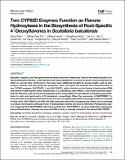| dc.contributor.author | Zhao, Qing | |
| dc.contributor.author | Cui, Meng-Ying | |
| dc.contributor.author | Levsh, Olesya | |
| dc.contributor.author | Yang, Dongfeng | |
| dc.contributor.author | Liu, Jie | |
| dc.contributor.author | Li, Jie | |
| dc.contributor.author | Hill, Lionel | |
| dc.contributor.author | Hu, Yonghong | |
| dc.contributor.author | Weng, Jing-Ke | |
| dc.contributor.author | Chen, Xiao-Ya | |
| dc.contributor.author | Martin, Cathie | |
| dc.contributor.author | Yang, Lei,S.M.Massachusetts Institute of Technology. | |
| dc.date.accessioned | 2018-07-13T16:31:15Z | |
| dc.date.available | 2018-07-13T16:31:15Z | |
| dc.date.issued | 2017-08 | |
| dc.date.submitted | 2017-08 | |
| dc.identifier.issn | 1752-9859 | |
| dc.identifier.issn | 1752-9867 | |
| dc.identifier.uri | http://hdl.handle.net/1721.1/116980 | |
| dc.description.abstract | Baicalein, wogonin, and their glycosides are major bioactive compounds found in the medicinal plant Scutellaria baicalensis Georgi. These flavones can induce apoptosis in a variety of cancer cell lines but have no effect on normal cells. Furthermore, they have many additional benefits for human health, such as anti-oxidant, antiviral, and liver-protective properties. Here, we report the isolation and characterization of two CYP450 enzymes, SbCYP82D1.1 and SbCYP82D2, which function as the flavone 6-hydroxylase (F6H) and flavone 8-hydroxylase (F8H), respectively, in S. baicalensis. SbCYP82D1.1 has broad substrate specificity for flavones such as chrysin and apigenin and is responsible for biosynthesis of baicalein and scutellarein in roots and aerial parts of S. baicalensis, respectively. When the expression of SbCYP82D1.1 is knocked down, baicalin and baicalein levels are reduced significantly while chrysin glycosides accumulate in hairy roots. SbCYP82D2 is an F8H with high substrate specificity, accepting only chrysin as its substrate to produce norwogonin, although minor 6-hydroxylation activity can also be detected. Phylogenetic analysis suggested that SbCYP82D2 might have evolved from SbCYP82D1.1 via gene duplication followed by neofunctionalization, whereby the ancestral F6H activity is partially retained in the derived SbCYP82D2. We report the characterization of two CYP450 enzymes, which 6- and 8-hydroxylate chrysin to form the 4′-deoxyflavone bioactives in roots of Scutellaria baicalensis. Like the main 4′-deoxyflavone enzymes, these decorating enzymes have evolved their functionalities by convergence with the more ubiquitous 4′-hydroxyflavone pathway enzymes. Key words: Scutellaria baicalensis; Huangqin; baicalein; wogonin; flavone 6-hydroxylase; flavone 8-hydroxylase | en_US |
| dc.publisher | Elsevier | en_US |
| dc.relation.isversionof | http://dx.doi.org/10.1016/J.MOLP.2017.08.009 | en_US |
| dc.rights | Creative Commons Attribution 4.0 International License | en_US |
| dc.rights.uri | http://creativecommons.org/licenses/by/4.0/ | en_US |
| dc.source | Elsevier | en_US |
| dc.title | Two CYP82D Enzymes Function as Flavone Hydroxylases in the Biosynthesis of Root-Specific 4′-Deoxyflavones in Scutellaria baicalensis | en_US |
| dc.type | Article | en_US |
| dc.identifier.citation | Zhao, Qing et al. “Two CYP82D Enzymes Function as Flavone Hydroxylases in the Biosynthesis of Root-Specific 4′-Deoxyflavones in Scutellaria Baicalensis.” Molecular Plant 11, 1 (January 2018): 135–148 © 2017 The Authors | en_US |
| dc.contributor.department | Massachusetts Institute of Technology. Department of Biology | en_US |
| dc.contributor.mitauthor | Levsh, Olesya | |
| dc.contributor.mitauthor | Weng, Jing-Ke | |
| dc.relation.journal | Molecular Plant | en_US |
| dc.eprint.version | Final published version | en_US |
| dc.type.uri | http://purl.org/eprint/type/JournalArticle | en_US |
| eprint.status | http://purl.org/eprint/status/PeerReviewed | en_US |
| dc.date.updated | 2018-07-13T12:34:43Z | |
| dspace.orderedauthors | Zhao, Qing; Cui, Meng-Ying; Levsh, Olesya; Yang, Dongfeng; Liu, Jie; Li, Jie; Hill, Lionel; Yang, Lei; Hu, Yonghong; Weng, Jing-Ke; Chen, Xiao-Ya; Martin, Cathie | en_US |
| dspace.embargo.terms | N | en_US |
| dc.identifier.orcid | https://orcid.org/0000-0002-8229-8642 | |
| mit.license | PUBLISHER_CC | en_US |
